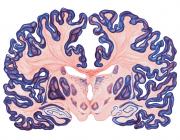Visuotopic organization of macaque posterior parietal cortex: a functional magnetic resonance imaging study.
Publication Year
2011
Type
Journal Article
Abstract
Macaque anatomy and physiology studies have revealed multiple visual areas in posterior parietal cortex (PPC). While many response properties of PPC neurons have been probed, little is known about PPC's large-scale functional topography-specifically related to visuotopic organization. Using high-resolution functional magnetic resonance imaging at 3 T with a phase-encoded retinotopic mapping paradigm in the awake macaque, a large-scale visuotopic organization along lateral portions of PPC anterior to area V3a and extending into the lateral intraparietal sulcus (LIP) was found. We identify two new visual field maps anterior to V3a within caudal PPC, referred to as caudal intraparietal-1 (CIP-1) and CIP-2. The polar angle representation in CIP-1 extends from regions near the upper vertical meridian (that is the shared border with V3a and dorsal prelunate) to those within the lower visual field (that is the shared border with CIP-2). The polar angle representation in CIP-2 is a mirror reversal of the CIP-1 representation. CIP-1 and CIP-2 share a representation of central space on the lateral border. Anterior to CIP-2, a third polar angle representation was found within LIP, referred to as visuotopic LIP. The polar angle representation in LIP extends from regions near the upper vertical meridian (that is the shared border with CIP-2) to those near the lower vertical meridian. Representations of central visual space were identified within dorsal portions of LIP with peripheral representations in ventral portions. We also consider the topographic large-scale organization found within macaque PPC relative to that observed in human PPC.
Keywords
Journal
J Neurosci
Volume
31
Pages
2064-78
Date Published
02/2011
ISSN Number
1529-2401
Alternate Journal
J. Neurosci.
PMID
21307244

